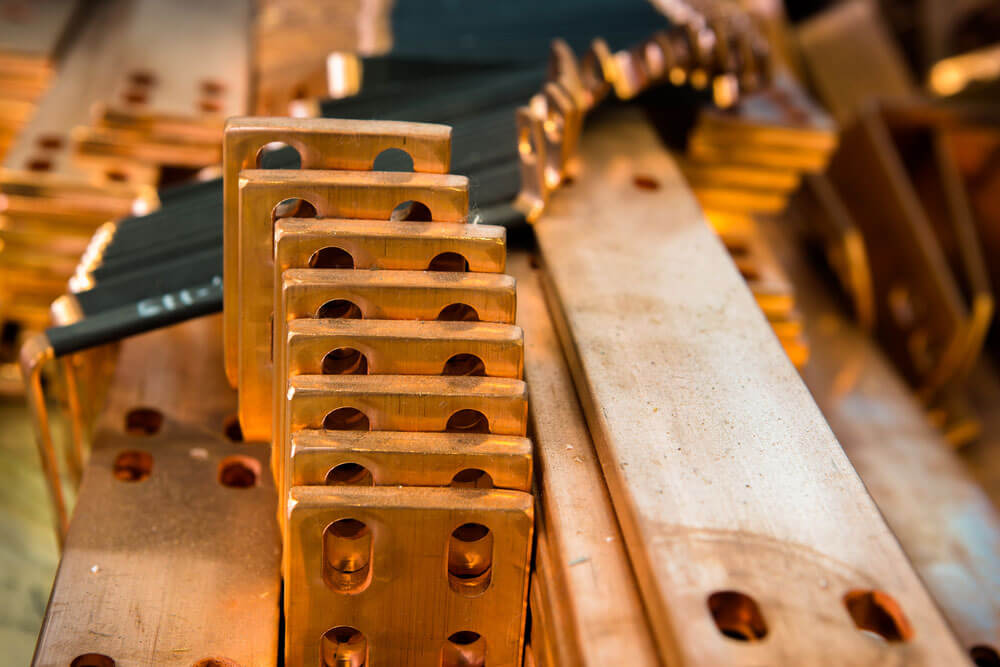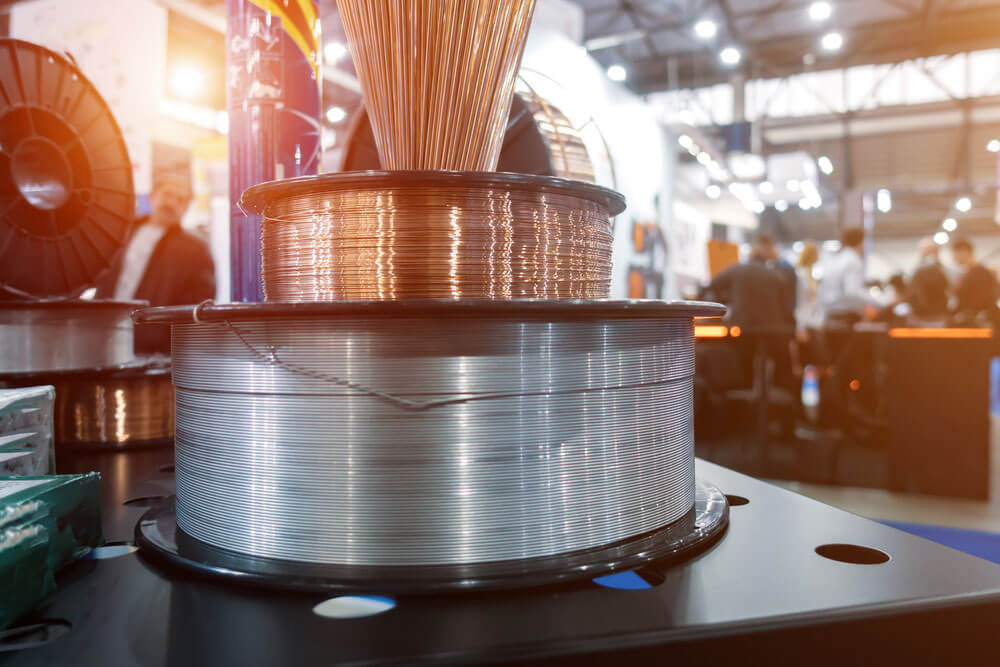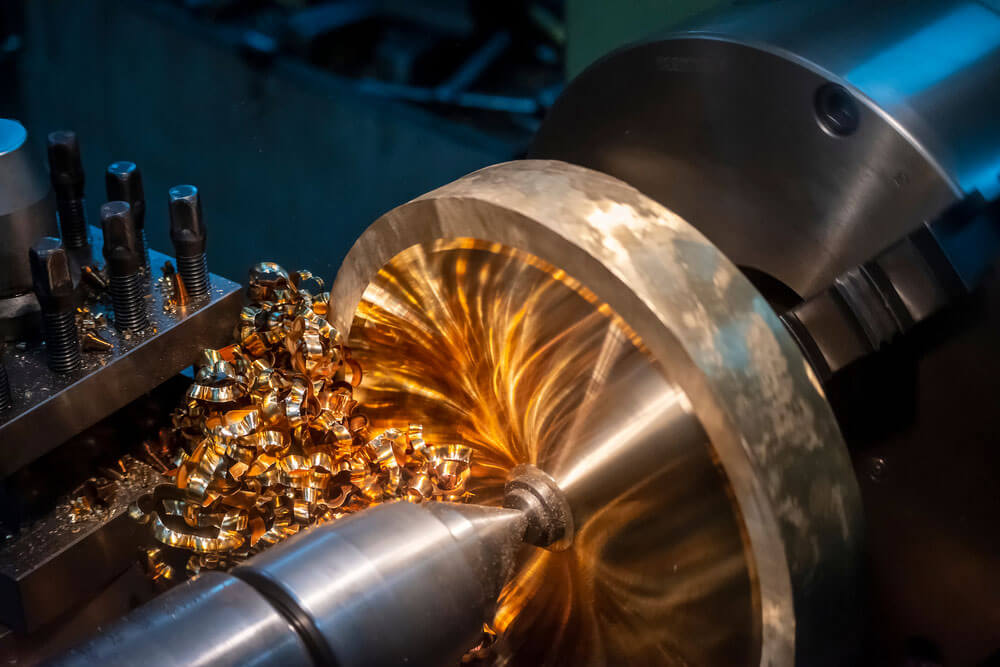What is copper?
Copper is a naturally occurring non-magnetic semi-precious, nonferrous metal found on the Periodic Table of Elements. It is present in nature, is distinguished by its reddish-orange color, and is one of the few metals directly suitable for processing. It is easily machined and is malleable. Copper can retain its original color when proper sealing is applied, though it will corrode and form a patina, which functions as a protective barrier, when exposed to oxidizing acids, heavy-metal salts, sulfur, and ammonia. Copper parts are ideal for construction and manufacturing due to copper’s unique properties.
Applications of Copper
Copper is known as a major industrial metal due to its high degree of electrical and thermal conductivity and its corrosion resistance, which is why copper is used for hundreds of applications in areas including electricity and electronics, transportation, plumbing, construction, and architecture. Copper is used in the automotive industry for the creation of gears, radiators, and hydraulic equipment. It is used in pipe systems, pumps, valves, and filters, and is used in the aerospace industry for wiring, navigation instruments, and cooling systems. Custom copper parts are used for the production of copper motorcycle parts to achieve a unique and smooth esthetic.

Properties of Copper
Copper is suitable for use in designing thermal equipment and electronic and electrical systems since it demonstrates excellent thermal and electrical conductivity. With a melting point of 1,981°F, pure copper has excellent corrosion resistance and superior heat transfer. It maintains its strength when flexed and exhibits resistance to various forms of damage including impact, corrosion, and wear. Copper also has bacterial antimicrobial resistance, which enables it to resist bacteria without degrading.
Copper Alloys
Although copper is used on its own, copper forms its own subset of alloys when combined with other metals. Copper alloys are metals created by combining two or more metallic elements, resulting in increased strength or corrosion resistance. Copper alloys are metal alloys that have a high resistance to corrosion and have copper as their main component. Copper is easily alloyed with other metals. Copper and copper alloys have a vast variety of uses due to their versatile chemical, physical and mechanical properties. Copper alloys include copper-nickels and copper-nickel-zincs, along with numerous other specialty alloys. The most known types of copper alloys are bronze and brass, which are commonly comprised of over 80% copper. Two popular copper alloys are ETP copper (C110) and OFC copper (C101). ETP Copper has long been sought out in the production of sheet, bus bar, square bar, round hod, strip and wire.

Bronze
Some of the properties that bronze shares with brass and copper include high ductility and excellent electrical and thermal conductivity. A few characteristics unique to bronze are its brittleness and a slightly higher melting point than brass. Though it varies depending on alloy ratio components, the melting point of bronze is typically around 1,742 °F. Bronze is a copper-based alloy and typically consists of 88% copper and 12% tin, though sometimes trace amounts of other metals including aluminum, manganese or nickel, zinc, or non-metals including phosphorus and silicon, may be present in the alloy. Bronzes are generally harder and more resistant to corrosion than brasses. Due to its corrosion resistance, processability, and ease of machining, bronze is typically used for electrical connectors, clips, springs, and automobile transmission pilot bearings.
Copper Vs Bronze
Bronze is a copper alloy and due to its copper content, it is known to oxidize and form a patina when exposed to air. Copper can also undergo oxidation to prevent corrosion by forming a patina. Whenever bronze comes into contact with chlorine compounds, it undergoes a process known as “bronze disease.” This causes its copper content to gradually diminish over time, preventing surface corrosion. Though both copper and bronze contain no iron, bronze naturally has a higher resistance to corrosion compared to copper, which is why bronze is commonly used in saltwater environments and in the application of marine parts and boat fittings. Another notable difference is that copper has a higher melting point than bronze. Pure metals have a thermal conductivity that remains constant with increasing temperature while metal alloys have a thermal conductivity that increases with temperature. Bronze, though made up primarily of copper, has a lower electrical conductivity, which is due to the presence of other alloying elements.
Brass
Brass is composed of generally 66% copper and 34% zinc, though the properties found in brass can be adjusted by varying the proportions of copper and zinc. This enables the formation of hard and soft brasses. With a melting point of 1,650 to 1,720 °F, brass is more malleable than bronze and is quite an easy material to cast. Brass alloys do not undergo internal galvanic corrosion due to the absence of a corrosive environment within the mixture of copper and zinc, though brass will corrode when exposed to moisture, ammonia, and certain acids. Brass is harder and more affordable than pure copper and is commonly used in many industries, due to its electrical and thermal conductivity, its low melting point, and corrosion-resistant properties. Brass, being durable and having high workability, has been widely used to make utensils as well as commonly used in applications requiring corrosion resistance and low friction including gears, ammunition casings, plumbing, electrical plugs, and sockets as well as musical instruments. It is often used as a substitute for copper pieces in designing jewelry.

The Difference Between Copper and Brass
The key difference lies in copper being a base metal while brass is an alloy. Copper is naturally found in the state it is in, while brass is a man-made metal. Brass is used for industrial and consumer goods production while copper is commonly used in electronics and electrical wiring, due to its high level of conductivity, which enables it to bend easily. Brass is commonly used in the production of furniture, home fixtures, and decorative items due to its durability and strength. Copper has a reddish-brown rustic appearance while brass can appear to have a yellowish hue due to the zinc content present in the alloy and is comparable to gold in its appearance. Copper is distinguished from brass since it has no magnetic properties, while brass is slightly magnetic.
PROPERTIES of ETP and OFC Copper
ETP and OFC coppers are both easy to work with during manufacturing since they are malleable and offer low levels of chemical reactivity combined with high levels of thermal and electrical conductivity. They are excellent choices for wire connectors, bus bars, and various other electrical applications. They contain resistance to corrosion, oxidation, and bacterial contamination.
ETP COPPER (C110)
With a 99.9% copper composition, ETP is essentially pure copper. ETP copper is a commercial copper and is used in numerous industries and for a wide variety of applications. It is resistant to corrosion, is solderable, and is more economical than OFC copper. It has a high range of fabrication methods and is known for having a high electrical conductivity. This is the most commonly used copper alloy since it is remarkably versatile and generally easier to machine, thereby more cost-efficient. It is popular for applications requiring low resistance levels such as electrical applications.
OFC COPPER (C101)
OFC, also known as superconductive copper, is a 99.99% pure copper alloy with 0.0005% oxygen content. It is less prone to hydrogen embrittlement and is resistant to oxidation. Due to its purity, OFC offers higher conductivity.
Copper CNC Machining
CNC stands for Computer Numerical Control and functions by relaying instructions into a machine that is responsible for controlling the lathes, routers, grinders, and mills. Excess material is removed, resulting in a part that is created according to exact specifications. CNC machining is highly customizable and precise, and creates projects with outstanding performance and physical properties. Copper is among the most versatile metals, which makes it the perfect choice for CNC machined custom parts. Due to copper having unique properties and benefits, it is a valuable metal used in various applications including CNC machining. Copper CNC machining uses copper components from copper blanks, solid copper bars, or cold-headed blanks to create precise customer-designed specialized projects. CNC machines can produce virtually any 3D object designed by CAD (Computer Aided Design) software. Operations include copper milling, slotting, tapping, drilling, threading, and grooving.
CNC Turning Vs Milling
The distinguishing factor between these two processes is that CNC milling keeps the material held in place as cutting tools rotate around it, while CNC turning rotates the material against a cutting tool.
CNC Machining Copper Vs Copper Alloys
Pure copper is a challenging metal to machine due to its high level of toughness and ductility. Alloying copper can improve its machinability, specifically when intricate custom shapes are required. With CNC machining, copper custom parts can be produced precisely and quickly, meeting specifications.